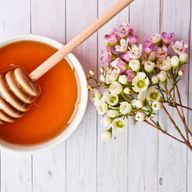
You’ve probably heard of the hype around manuka honey, particularly during the winter months. You may well be considering buying a jar yourself but are unsure what’s special about it. It’s natural to wonder about this type of honey and you wouldn’t be the only one; there are over 60,000 searches each month for ‘manuka honey’. However, there’s a variety on the shop shelves at different price-points, so it can be a sticky topic.
Let’s start from the very beginning; what is manuka honey and how is it different to other honey? Manuka honey is produced by honey bees that collect nectar from the flowers of the manuka tree, found in the green and luscious hills of the North and South Islands of New Zealand, as well as Australia and Tasmania. The manuka flower only blooms for a few weeks each year, so there is high demand for a limited supply — and that’s why it tends to be more expensive.
But it’s not just where it’s from that makes it so special. Manuka honey has what’s called MGO (methylglyoxal) content, which is a unique compound that is only found in this type of honey. This naturally occurring ‘magic ingredient’ is produced from high levels of dihydroxyacetone — a natural chemical that’s present in the nectar of manuka flowers. The higher the MGO rating, the higher the MGO content of the manuka.
How do you know you’re getting authentic Manuka Honey?
There are ratings used to determine the level of active MGO in each jar or, in other words, the strength of MGO within manuka honey. If you’re pondering ‘which manuka honey is best?’ and want to guarantee you’re getting authentic manuka honey, check its MGO content. This honey should have a substantial amount of MGO to be an authentic manuka, so we strongly recommend anything in excess of 100 MGO.
Unfortunately, the lack of legal guidelines around manuka honey in the UK means inauthentic versions do exist; these are diluted with cheaper honey, so contain very little MGO content at all. The late Professor Peter Molan, who founded the Honey Research Unit at the University of Waikato and dedicated over 30 years of his life to investigating manuka, warned: “A considerable amount of manuka honey sold is not genuine.” This means “there’s a distinct gap in what consumers are paying for and what they’re actually getting.”
To try to address this, we created The Rowse Campaign for Real Manuka to ensure you’re not only getting value for money, but that the authenticity of this much-loved product is protected. In fact, all Rowse manuka honey is tested twice for its authenticity; at source in New Zealand and again on arrival in the UK – so it guarantees authenticity. Not only that, but through our Hives For Lives programme of vital initiatives, we have pledged to protect the incredible bees all over the world that create the different forms of this liquid gold. So, we’re well-placed to share all you need to know about manuka. Here are some more buzzing bites of knowledge:
- Be mindful when buying manuka online -— where it’s frequently re-sold — as authenticity isn’t guaranteed. To be on the safe side, buy manuka honey with a minimum MGO of 100 and through trusted brands who offer good value for money on manuka honey
- Look out for labels that clearly state the MGO or the NPA level – both can be used. NPA is Non-peroxide Activity and it’s this that defines the level of MGO (so our 100+ MGO Manuka has an NPA of 6+, our 250+ MGO Manuka has an NPA of 10+ and our 500+ MGO Manuka has an NPA of 15+ – all clearly stated on the jars)
- Manuka is more distinctive than other honeys with its thicker consistency, dark amber colour and rich, herbal favour
- Manuka, like all honey, is complex and variable. Many supermarket bought manuka honeys are for consumption only and not external use. Make sure you read the labels carefully
- Manuka honey can be enjoyed straight off the spoon, or you can stir a couple of teaspoons into hot water and perhaps add a squeeze of lemon and ginger for a tasty, warming beverage
- If you’re feeling more adventurous, you can let your culinary creativity run wild and make some Manuka Honey Energy Balls to put a pep in your step or a Re-Energizing Citrus Salad with Manuka Honey and Mint as a refreshing side dish. Is your mouth watering yet?
Manuka truly is the bees knees. So, ensure the one you’re buying is 100% pure and authentic by purchasing it from reliable brands and stockists. A deliciously comforting lemon and honey drink or manuka honey spread on hot toast will taste all the better knowing you’re consuming the real deal.



